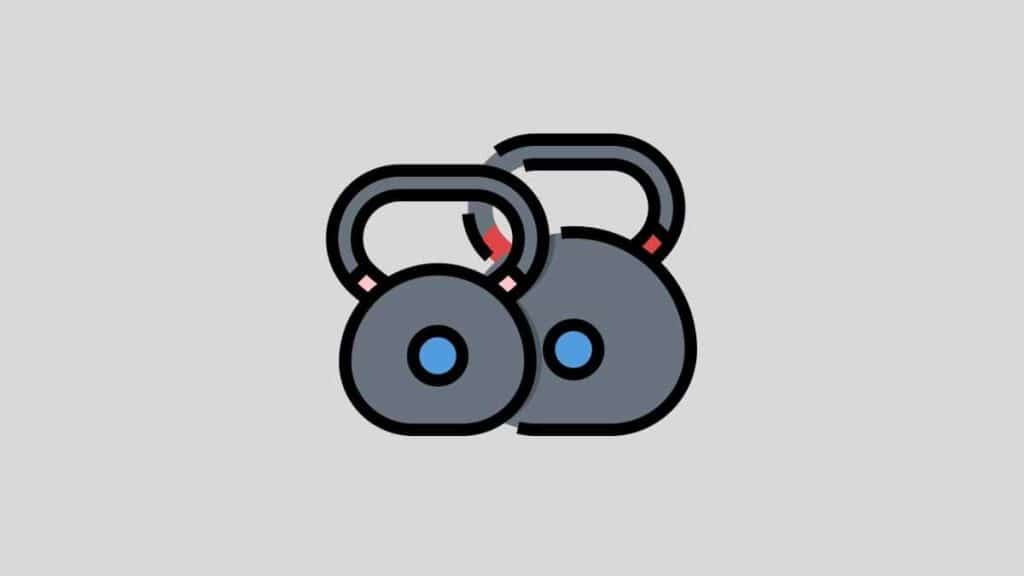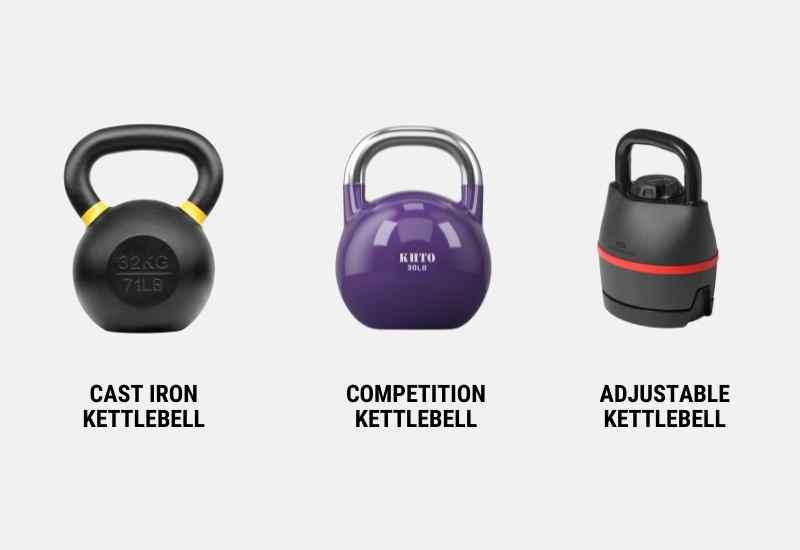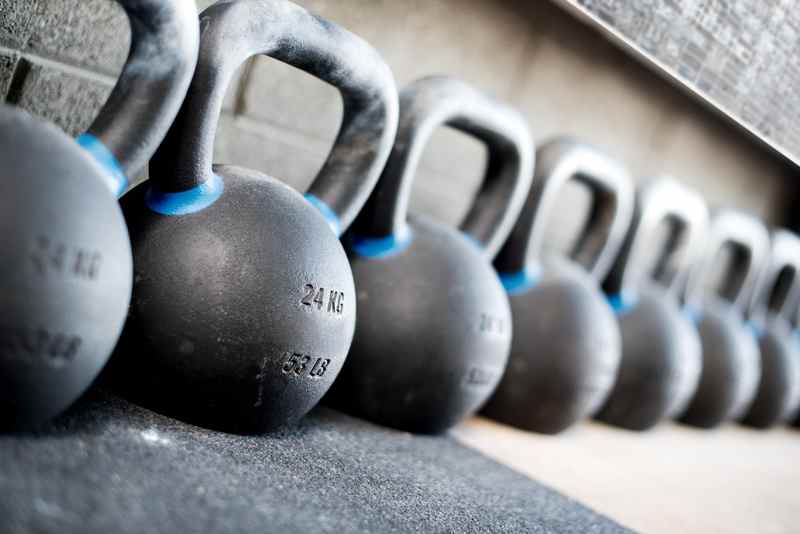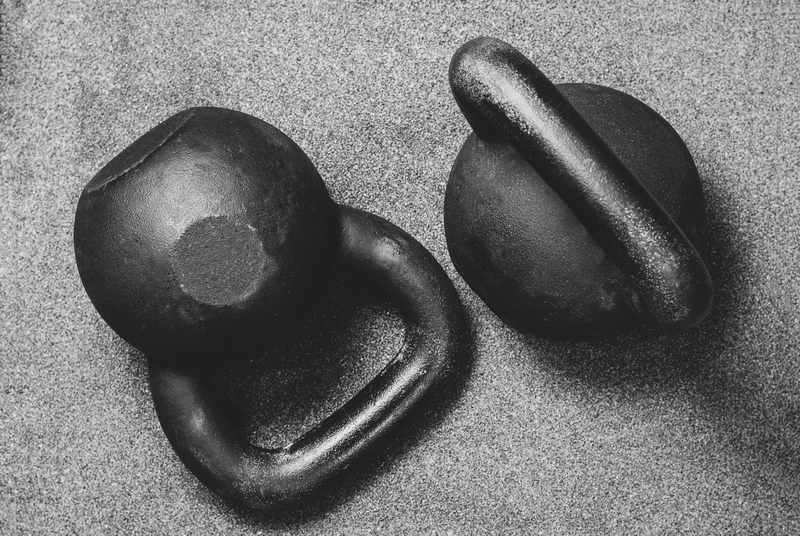In the market for a kettlebell but don’t know what size or weight to start with? Here’s a complete guide to kettlebell sizing, including colors, types of kettlebells, and more.

Kettlebells are one of the most versatile pieces of gym equipment you can own—and one of the best for getting a truly kickass, dynamic workout.
They make a great addition to your home gym setup, and even just a small collection will allow you to do an impressive number of exercises.
If you’re wondering, “What kettlebell should I buy?” you’ve come to the right place!
In this article, we’ll talk about the different types of kettlebells, what factors to look for when kettlebell shopping, and even look at what the different colors mean.
By the end of this post, you’ll know exactly what you need in order to buy the right kettlebell (or an assortment of kettlebells) for your gym.
Let’s get to the swinging!
The Different Types of Kettlebells

Let’s start off by talking about the three types of kettlebells available to you on the market:
Cast Iron Kettlebells
Cast iron kettlebells are made in the style of the Russian kettlebells that first made a splash in the international fitness community.
They tend to have a handle wider than the bell itself, with a thicker bar.
Pros:
- It’s the most versatile type of kettlebell, useful for both one- and two-handed movements.
- The wider/thicker handle makes it easier to grip, great for those who are training grip strength.
- They tend to be cheaper and more easily available
- Ideal for casual or recreational use
Cons:
- Not great for people with small hands
- Not compatible with formal competitions
Competition Kettlebells
Competition kettlebells are typically made of steel, with smaller handles (both smaller in width and diameter), and always built-in specifically regulated dimensions.
These tend to be identical across the board because of their use in formal competitions.
Pros:
- Ideal for anyone with smaller hands
- Great for preparing to compete in formal competitions
- Great for one-handed movement training
- More seamless movement in swings and lifts
Cons:
- More expensive and harder to find
- Not suitable for two-handed training
Adjustable Kettlebells
Adjustable kettlebells are typically designed in the same shape as cast-iron kettlebells (wider handle compatible with two-handed grip) but with a mechanism that allows you to adjust the amount of weight being lifted.
Pros:
- Great for one- and two-handed training
- Replaces a full rack of kettlebells
- Easy to adjust between various weights in a matter of seconds
- More affordable
Cons:
- Less durable than solid steel or cast iron kettlebells
- Don’t accommodate heavier loads
The Color Codes on Kettlebells
When shopping for kettlebells (particularly competition kettlebells), you’ll find that each weight is a different color.
This makes it easy for you to instantly identify the weight at a glance, making it easier to shift between various weights quickly.

The colors are as follows:
- Pink: 8 kg / 17.6 lbs
- Blue: 12 kg / 26.4 lbs
- Yellow: 16 kg / 35.2 lbs
- Purple: 20 kg / 44.0 lbs
- Green: 24 kg / 52.8 lbs
- Orange: 28 kg / 61.6 lbs
- Red: 32 kg / 70.4 lbs
- Grey: 36 kg / 79.2 lbs
- White: 40 kg / 88.0 lbs
- Silver: 44 kg / 96.8 lbs
- Gold: 48 kg / 105.6 lbs
Key Decision Factors When Choosing the Right Kettlebell for You
When kettlebell shopping, here are the most important factors you should take into account:
? Intended Use
Kettlebells are typically used for two types of exercises:
- Ballistic exercises, which involve a lot of swinging movements and movements that similar throwing.
- Grind exercises, which involve slower, more controlled movements, such as presses, curls, etc.
For ballistic exercises, you want a kettlebell designed to “swing”, one you can usually use two-handed. Cast iron Russian-style kettlebells typically work better for this type of exercise.
See also: 10 Benefits of Kettlebells (and Should You Do Them Every Day?)
For grind exercises, however, you may want a more balanced, controlled style of weight—the competition kettlebell.
The design will make it easier to maneuver and manipulate through your more precision-focused exercises.

? One-Handed vs. Two-Handed Training
If you’re focusing entirely on one-handed unilateral training, a competition kettlebell will be a great choice, thanks to its more balanced design.
However, anyone who wants to do two-handed exercises will need a kettlebell with a larger handle sized for a two-handed grip—ergo, a cast iron Russian-style kettlebell, or an adjustable kettlebell.
? Material
Cast iron kettlebells are durable enough to withstand daily use without breaking or cracking. Typically, they’re finished with some kind of coating (see the next section) that ensures durability and makes it comfortable to hold.
However, at their core, they’re still cast iron, a metal that is prone to rusting if left out in the elements. If your gym setup is outdoors, a cast iron kettlebell may not be your top pick.
Steel competition kettlebells are typically made using stainless steel, which is resistant to rust and corrosion even if left outside. Steel is also very tough and able to withstand a lot of damage without breaking/cracking.
? Coating/Handle
The coating on the kettlebell can play a huge role in how long it lasts and how comfortable it is.
Many cast iron kettlebells will use a rubber coating that not only protects the metal from moisture, but also gives the handle a bit of additional grip and reduces the wear and tear on your palms. Some will use a powder coating that has the same effect.
Competition kettlebells will usually feature rubber or ABS plastic around the bell (colored according to the codes listed above) but leave the handle uncovered and untreated. While the steel will be smoother on your hand, it’s also harder to grip (it’s slicker than rubber or powder-coating).
? Competition
If you plan on competing, you’ll want to buy yourself a stainless steel kettlebell that is designed according to the standard regulations.
That way, you’ll be training with the exact same equipment that you’ll use to qualify for and eventually compete in whatever formal competition you’re working toward.
However, if you don’t plan to compete, you can use whatever type of kettlebell is easiest and best-suited to your training plan (see above).
? Durability
Both cast iron and competition kettlebells are designed to last for years (even decades!) without wearing out, cracking, rusting, or breaking.
Sadly, the same can’t be said about adjustable kettlebells. While they are more versatile, they lack the durability of solid metal kettlebells.
You can expect to get 3-7 good years of training with the adjustable kettlebell before some mechanism breaks or it gets damaged. They’re also not quite as impervious to rust or corrosion as solid kettlebells.
? Space Available
If you’re trying to equip a full-sized commercial gym, it’s no big deal to buy a full array of kettlebells (either competition or cast iron, or both!) and store them in racks along the wall. However, when talking about equipping a home gym, things are a bit different.
Adjustable kettlebells are an amazing choice for home resistance trainees because they give you a versatile, adjustable weight all in one piece of equipment. You may need to eventually upgrade to heavier weights after a year or two of regular training, but initially, it’s a great option for anyone operating with limited space.
? Cost
Finally, you’ve got to factor in cost. Competition kettlebells are noticeably pricier than cast iron kettlebells, so you’ll spend a lot more equipping your gym if you’re going the stainless steel route.
Adjustable kettlebells tend to cost more than either cast iron or competition, but because you only need to buy one for all your workouts, you end up spending less in the long run.
What’s the best weight kettlebell for beginners?
That depends a lot on your current fitness level. However, a rough guide to follow is:
- Men should have kettlebells within the 24 to 35-pound range.
- Women should have kettlebells within the 13 to 18-pound range.
- Children should have kettlebells within the 5 to 15-pound range.
- Teenagers should have kettlebells within the 10 to 20-pound range.
You can always add more weights as needed, but at least with this selection, you’ve got enough to get started training.
What size kettlebell should I use for weight loss?
When it comes to weight loss, size doesn’t matter as much as intensity!
Ballistic and dynamic exercises (like kettlebell swings) engage your cardiovascular system as well as your muscles, leading to more calorie and fat-burning for every set you do.
Ideally, you want to start off with less weight so you can perform more reps SAFELY and UNDER CONTROL.
Once you master the form and build conditioning, you can up the weight as desired. However, more reps/sets with fewer rest periods between (high-intensity interval training) will be ideal for promoting weight loss.
Should I get one kettlebell or two?
For beginners, it’s always best to start working out with just one kettlebell, typically doing two-handed exercises. This allows you to perfect the form and build strength evenly.
Over time, as you master the exercises and form, you can switch from two-handed training to one-handed training.
You may need a second kettlebell if you want to work both arms/sides of your body at once, rather than the asymmetrical training of one-handed kettlebell lifts. Whether you add a second weight or stick with just one will depend on your ultimate training goals.
The Bottom Line
Kettlebells can make an excellent addition to your home gym, so it’s worth researching to find which is the right kettlebell for you and which will suit your needs best.
Hopefully, the information above helped you to figure out the best option for your specific training and setup. Now you’re ready to buy a kettlebell (or two) and get training like an absolute monster.
More Kettlebell Guides and Resources
Kettlebells vs Dumbbells: Pros, Cons, and Differences. Kettlebells and dumbbells are two of the most popular tools for resistance training. But which is best for you? In this guide, we’ll look at the key differences between kettlebells and dumbbells so you can choose the right tool for your training.
Best Rogue Kettlebells for Cranking Up Your Workouts (Full Review). Looking to pick up a Rogue kettlebell? Here is a full rundown and reviews of the best Rogue kettlebells for demolishing your workout goals.